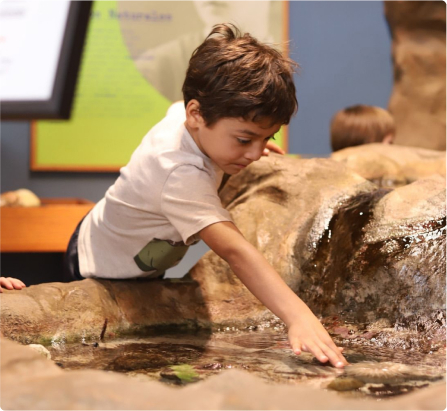
Accessibility
The Museum is committed to ensuring accessibility for all visitors within our facility.
Mobility
The Museum’s exhibits exist on one floor and can be accessed via ramps with no obstacles. Stools, chairs and benches are spread throughout the galleries. The grey whale statue can be reached via a gravel path through our Coastal Terrace garden at the front of the Museum.
Service Animals
For the wellbeing of our live animals and our exhibits, and in accordance with the ADA, the SCMNH only permits trained service animals inside the Museum. Pets, therapy or emotional-support animals are not permitted.
Admission
Adult visitors with disabilities will receive discounted admission at the Senior rate ($3) upon request. One-to-one aides or attendants of guests with disabilities receive complimentary admission. This includes one family member or friend who is serving as an interpreter for deaf guests or as a guide for blind guests. Guests with foster youth may also receive free admission upon request (youth always free).
Parking
Vehicles with a valid disabled parking placard or sticker may park in any Museum designated space along Pilkington Ave. without the need for a parking permit. There is a single disabled parking space at the corner of East Cliff Drive and Pilkington Ave. The front door of the Museum is accessible via ramps from parking along Pilkington Ave.
Bathrooms
The public floor of the Museum has two single stall bathrooms, both of which are handicap accessible. Each bathroom is gender neutral and includes a baby changing station.
Multilingual Materials
Exhibit labels in our First Peoples, Santa Cruz Naturalist and Shoreline to Summit exhibits include Spanish and English text.
Sensory Considerations
Our Sensory Backpack is a free resource for all ages that can be borrowed from the front desk reception area. It includes a range of tools that can be used to both calm and stimulate the sensory system to help make visits to the museum a more enjoyable experience. Visitors are welcome to contact the Museum in advance to see if there are school tours or other large groups scheduled to be in the building during your planned visit. If you are looking for a quieter visit, afternoons in the middle of the week tend to be less crowded.
Adaptive backpack includes: ear defenders (youth), dark glasses, sensory plushie, fidgets, magnifying glass, notebook and pencil, timers, communication cards, emotion cards. Some of the items may not be suitable for children under five years of age. Children using backpacks must be monitored by an adult.
 The Museum has many opportunities for multi-sensory interactions:
The Museum has many opportunities for multi-sensory interactions:
- Listen to honey bees buzz and feel the warmth of their hive
- Explore our live tidepool animals with gentle touches
- Grind acorns in authentic stone mortar and pestles
- Listen to the songs of common birds
- Touch various specimens and examine them under a microscope
- Interact with our changing Investigation Stations





















